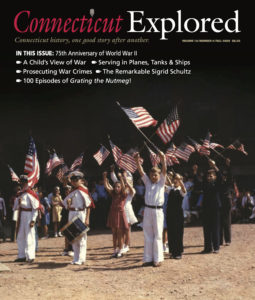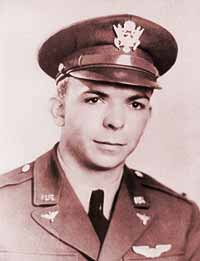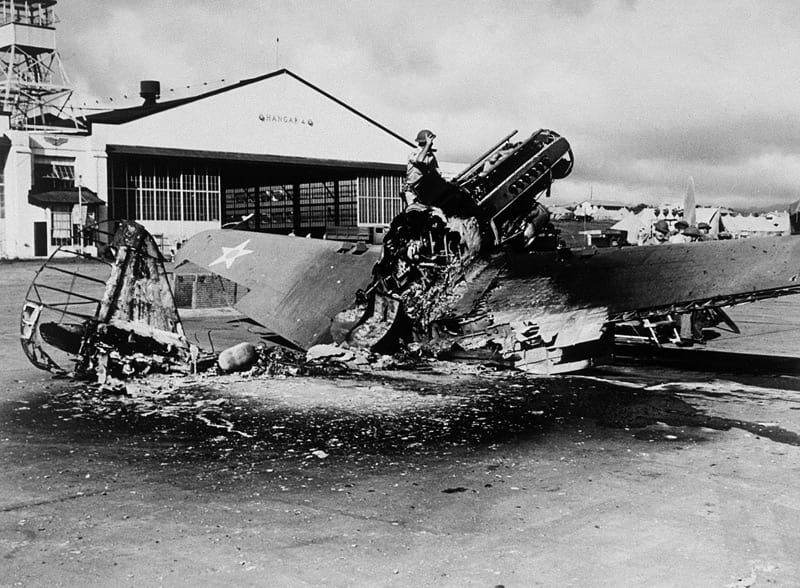(c) Connecticut Explored Inc. Fall 2020
Subscribe/Buy the Issue!
Of the 17 Connecticans among the 2,403 people who died at Pearl Harbor on December 7, 1941, only 12 served on U.S. Navy ships. Five others were connected with military flight operations at the Army’s nearby Wheeler and Hickam airfields. After the first wave of the Japanese attack, West Hartford’s Gordon H. Sterling Jr., a not-yet-fully-qualified Army Air Corps fighter pilot, got an antiquated P-36 Hawk into the skies and died, guns blazing, in pursuit of an enemy Zero. For his courage in combat, Sterling posthumously received the Distinguished Flying Cross, making him Connecticut’s first officially recognized World War II hero.
Born in upstate New York, Sterling moved with his family to West Hartford in 1934, at age 15. An active member of a local Boy Scout troop, he also thrived as a student at Hall High School, from which he graduated in 1937. Sterling attended Trinity College in Hartford for two years. Then, his interest in aviation led him to Pratt & Whitney in East Hartford, where he worked on aircraft engines while taking private flying lessons. He joined the Army Air Corps in September 1940.
In the Japanese plan to inflict a surprise, knock-out blow to American naval power in the Pacific, Army airfields were primary targets. Twenty-five dive bombers were assigned to Wheeler Field alone, and within minutes of the 7:55 a.m. attack the base was devastated: ammunition stockpiles blown up, hangars destroyed, and 83 of the 146 airplanes on the ground in pieces or incapable of flight. During the next two hours, more than 700 Army Air Corps personnel in the area were killed or wounded. In the ensuing chaos, only six of the planes at Wheeler made it off the ground.
Sterling had earned his wings, but he had fallen behind in combat training and gunnery and was only qualified as the squadron’s assistant flight engineer. As crews readied a few of the antiquated P-36 Hawks—the only planes still capable of flight—for a rushed takeoff, Sterling, watched a sortie of four Hawks sitting idle as one of the pilots went to get a better-fitting parachute harness. Sterling ran to one of those airplanes and climbed into the cockpit. As the flight crew strapped him in, he took off his watch and said, “See that my mother gets this. I won’t be coming back.”
Led by Lieutenant Lewis M. Sanders, the planes succeeded in reaching 11,000 feet before the second wave of Japanese attackers arrived. Though overwhelmingly outnumbered, the Americans acquitted themselves well in the ensuing dogfights. Sanders later reported that after inflicting damage on one enemy fighter, he turned and saw Sterling in a vertical dive firing shots into a Japanese Zero. Then a second Zero latched onto Sterling’s tail, firing into the Hawk. Sanders followed, and all four planes fought while diving toward the ocean. Sanders pulled out in time, but Sterling did not. The fate of the Japanese Zeroes is disputed, but Sanders claimed all three planes must have hit the water.
Gordon H. Sterling, Connecticut’s first World War II hero, died a hero’s death in the waters off Pearl Harbor. His body was never recovered. Monuments to his memory were erected at Pearl Harbor and Arlington National Cemetery. His watch was sent home to his mother. In May 1943, the West Hartford town council voted to name its new athletic center Sterling Field. Little League games are still played at Sterling Field, behind Charter Oak Academy in West Hartford, though one wonders how many of the children playing there know the story of the hero for whom the park is named.
Receive each beautiful and informative issue! Subscribe Today!
Read more of Walt Woodward’s columns HERE.
Read more stories about World War II on our Connecticut at War TOPICS page.



